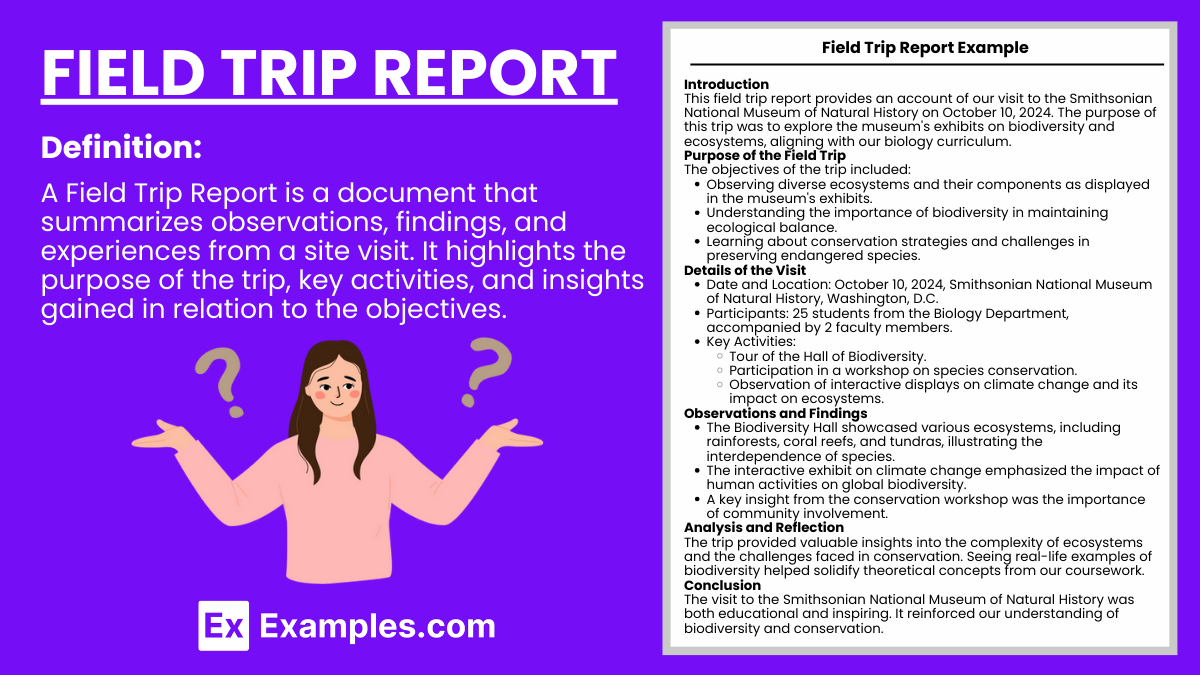10+ Field Trip Report Examples to Download
A Field Trip Report is a detailed account of observations, insights, and experiences gathered during a visit to a specific site or location. It serves as a formal trip report or visit report, documenting key findings and their relevance to the objectives of the visit. This report is commonly used in education, research, and professional contexts to summarize and analyze field experiences.
What is Field Trip Report?
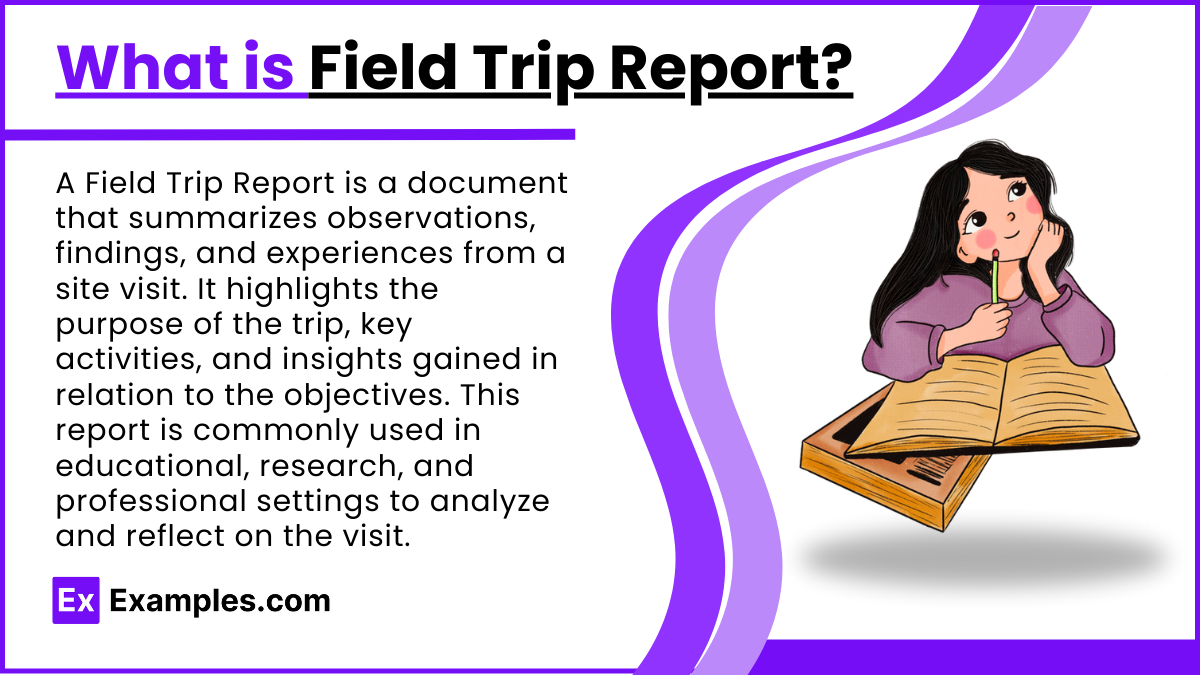

Download Field Trip Example Bundle
Field Trip Report Format
Introduction
A field trip report provides a detailed account of a visit to a specific location for educational, research, or professional purposes. It documents the objectives of the trip, observations made, and the insights gained during the experience. This report is essential for reflecting on the activities conducted and analyzing their relevance to the goals of the trip.
Purpose of the Field Trip
Clearly state the objectives of the trip, such as:
- To observe and study [specific area or topic].
- To gather information relevant to [specific project or research].
- To experience real-world applications of [specific concepts or theories].
Details of the Visit
Include specifics such as:
- Date and Location: When and where the trip took place.
- Participants: Who attended the trip (e.g., students, faculty, professionals).
- Key Activities: A summary of what was done during the visit, such as site tours, hands-on activities, or interviews.
Observations and Findings
Describe the key takeaways, such as:
- Significant observations or discoveries.
- How these observations relate to the objectives of the trip.
- New knowledge or perspectives gained.
Analysis and Reflection
Provide an analysis of the findings:
- Discuss how the trip contributed to a deeper understanding of the subject.
- Reflect on any challenges or unexpected outcomes encountered.
- Highlight how the experience can be applied to future learning or projects.
Conclusion
Summarize the overall experience of the trip and its impact on the participants. Reinforce the importance of such trips in achieving the stated objectives and gaining practical insights.
Field Trip Report Example
Introduction
This field trip report provides an account of our visit to the Smithsonian National Museum of Natural History on October 10, 2024. The purpose of this trip was to explore the museum’s exhibits on biodiversity and ecosystems, aligning with our biology curriculum. The visit aimed to enhance our understanding of real-world ecological interactions and conservation efforts.
Purpose of the Field Trip
The objectives of the trip included:
- Observing diverse ecosystems and their components as displayed in the museum’s exhibits.
- Understanding the importance of biodiversity in maintaining ecological balance.
- Learning about conservation strategies and challenges in preserving endangered species.
Details of the Visit
- Date and Location: October 10, 2024, Smithsonian National Museum of Natural History, Washington, D.C.
- Participants: 25 students from the Biology Department, accompanied by 2 faculty members.
- Key Activities:
- Tour of the Hall of Biodiversity.
- Participation in a workshop on species conservation.
- Observation of interactive displays on climate change and its impact on ecosystems.
Observations and Findings
- The Biodiversity Hall showcased various ecosystems, including rainforests, coral reefs, and tundras, illustrating the interdependence of species.
- The interactive exhibit on climate change emphasized the impact of human activities on global biodiversity.
- A key insight from the conservation workshop was the importance of community involvement in protecting endangered species.
Analysis and Reflection
The trip provided valuable insights into the complexity of ecosystems and the challenges faced in conservation. Seeing real-life examples of biodiversity helped solidify theoretical concepts from our coursework. One challenge was the time limitation, which made it difficult to explore all exhibits in depth. Overall, the trip deepened our appreciation of ecological balance and motivated us to think critically about our role in conservation efforts.
Conclusion
The visit to the Smithsonian National Museum of Natural History was both educational and inspiring. It reinforced our understanding of biodiversity and conservation, offering practical insights into the challenges faced by ecologists. Field trips like this are crucial in bridging classroom knowledge with real-world applications.
Field Trip Report for Students
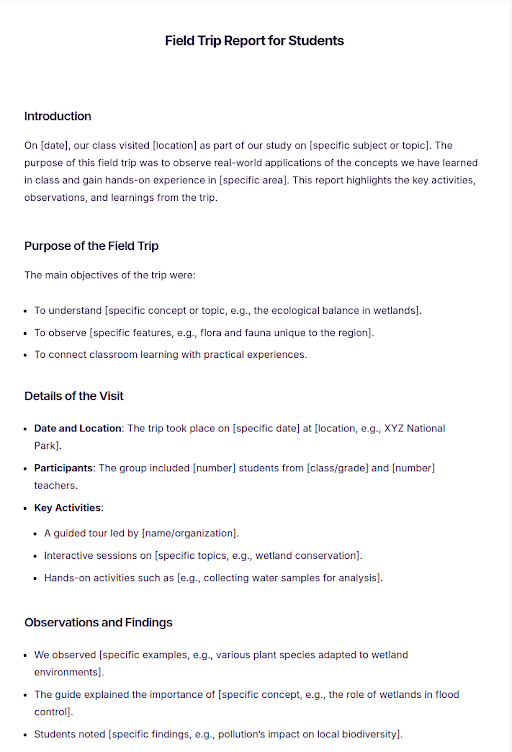
Field Trip Report by Teacher
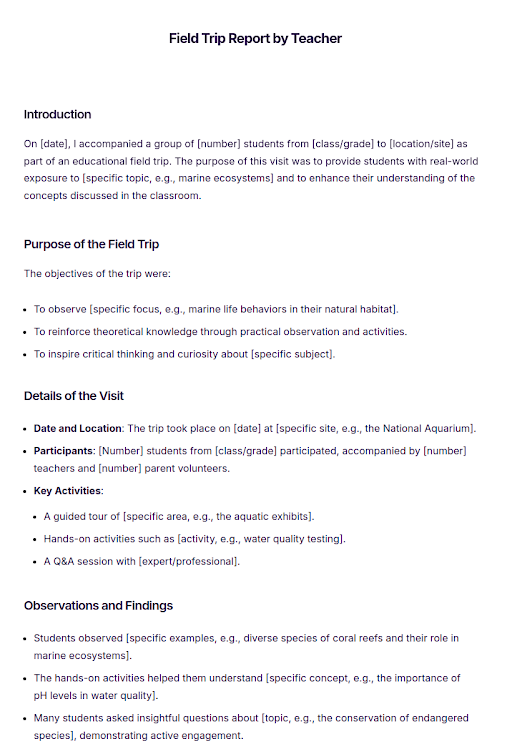
Field Trip Report for B.ED

More Field Trip Report Examples and samples
- Field Trip Report on Water Treatment Plant
- Salesforce Field Trip Report
- Agricultural Field Trip Report
More Field Trip Report Examples
1. Data Field Trip Report
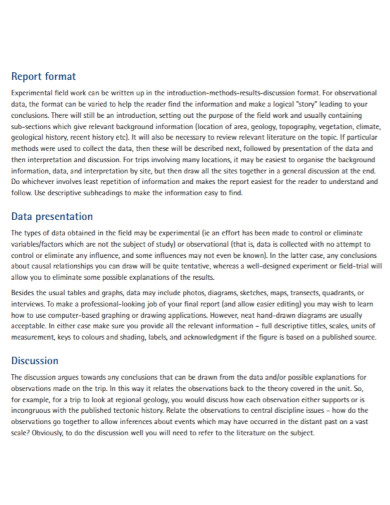
2. Field Trip Report Template
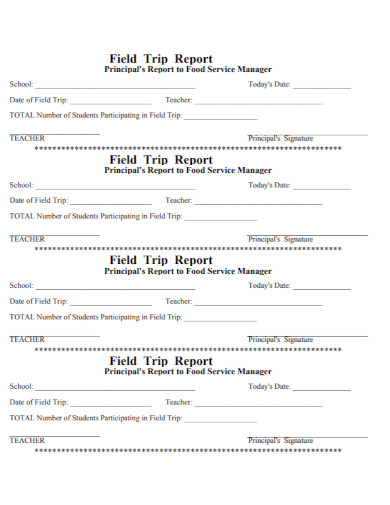
3. Formal Field Trip Report
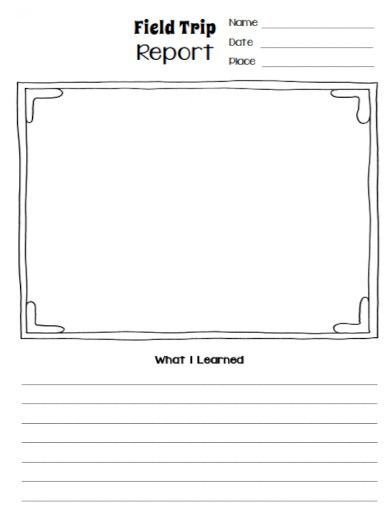
4. Professional Field Trip Report
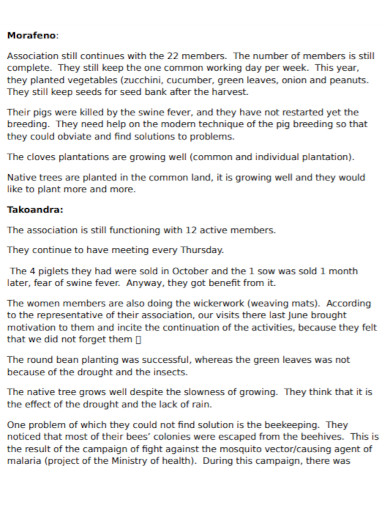
5. Field Trip Report in PDF
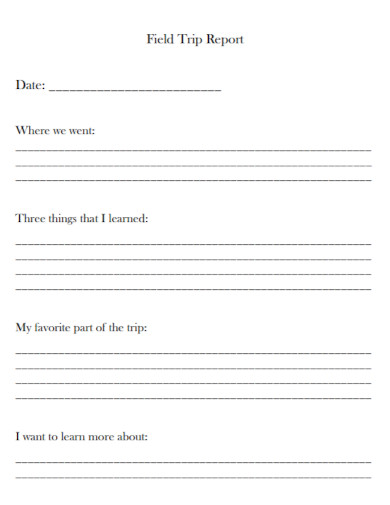
6. General Field Trip Report

7. Temple Field Trip Report

8. Field Trip Report Form
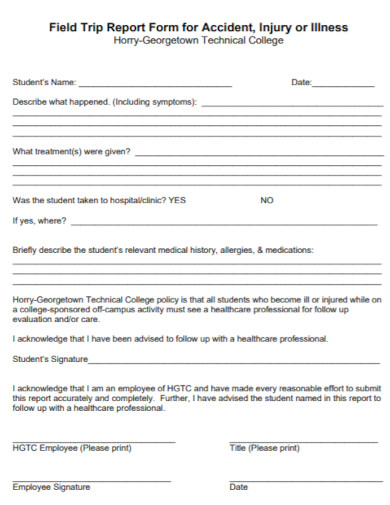
9. Draft Field Trip Report
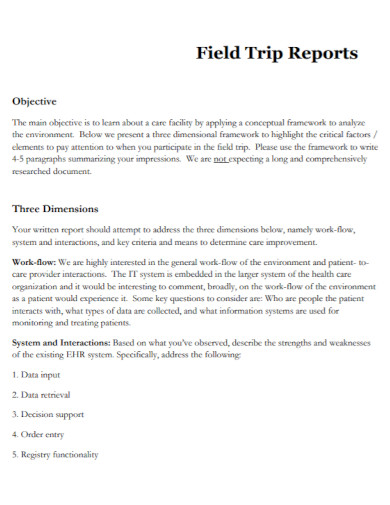
10. Construction Field Trip Report
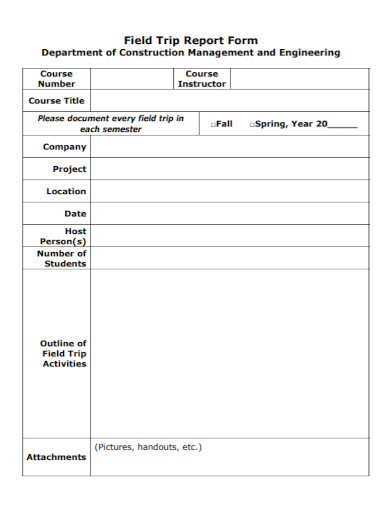
What is the Purpose of a Field Trip Report?
The purpose of a field trip report is to document and analyze the experiences, observations, and learning outcomes from the field trip. It serves several key objectives:
- Educational Reflection: Helps participants reflect on what they learned during the trip and connect it to theoretical knowledge or academic concepts.
- Documentation: Provides a detailed record of the activities, observations, and findings from the trip, which can be referred to later.
- Evaluation: Assesses the effectiveness of the trip in achieving its intended objectives and educational goals.
- Knowledge Sharing: Allows participants to share insights and observations with others who did not attend, contributing to a broader understanding.Field trips do require reports. Download these examples of field trip reports now.
- Critical Thinking: Encourages analysis, interpretation, and synthesis of the information gathered during the trip.
- Feedback and Improvement: Identifies challenges faced during the trip and suggests ways to enhance future trips or learning activities.
How to Write a Field Trip Report
Writing a field trip report involves organizing your observations and experiences from a site visit into a structured and reflective document. Follow these steps to create an effective report:
1. Start with a Title Page
Include:
- The title of the report (e.g., “Field Trip Report: Visit to Yellowstone National Park”).
- Your name, group, or class.
- The date of the trip and the report submission date.
2. Write an Introduction
- Clearly state the purpose of the field trip.
- Mention the location, date, and participants.
- Briefly describe the objectives and relevance of the trip to your studies or research.
3. Describe the Purpose of the Trip
Explain:
- Why the trip was organized.
- The key learning outcomes or research goals.
- How it connects to your coursework or research.
4. Provide Details of the Visit
Include specific information about the trip:
- Date and Location: When and where the trip took place.
- Participants: Who was involved, such as classmates, teachers, or colleagues.
- Activities: List key activities, such as tours, workshops, experiments, or observations.
5. Record Observations and Findings
- Describe what you saw, learned, or experienced during the trip.
- Highlight important insights, facts, or discoveries.
- Relate these findings to the objectives of the trip or the subject matter.
6. Analyze and Reflect
- Reflect on how the trip contributed to your learning or research.
- Discuss challenges or unexpected outcomes, if any.
- Share how the trip deepened your understanding of the topic.
7. Write a Conclusion
- Summarize the overall experience and its significance.
- Reiterate the importance of the trip in achieving its goals.
- Mention any broader implications or lessons learned.
8. Add Recommendations (Optional)
- Suggest improvements for future trips (e.g., better planning, longer duration).
- Propose follow-up activities or further research related to the trip.
9. Format the Report
- Use clear headings and subheadings (e.g., Introduction, Observations, Conclusion).
- Keep your writing concise and organized.
- Include photos, charts, or maps if relevant, ensuring they are labeled properly.
10. Proofread and Edit
- Check for grammar, spelling, and formatting errors.
- Ensure that the report flows logically and meets any specific requirements provided by your teacher or organization.
What Information Should Be Included on a Field Trip Report
A comprehensive field trip report should include the following information:
- Title and Date: The title of the trip and the date it occurred.
- Purpose: Clearly state the objective of the field trip and its relevance.
- Location: Provide details of the site(s) visited, including the name, address, and notable features.
- Participants: List attendees, including students, teachers, and guides (if applicable).
- Itinerary: Outline the schedule and key activities conducted during the trip.
- Observations: Record detailed notes on what was observed, including specific findings, insights, or data collected.
- Learning Outcomes: Highlight the educational aspects, skills gained, or knowledge acquired.
- Analysis and Reflection: Discuss how the trip aligns with academic goals or personal learning experiences.
- Challenges and Recommendations: Note any difficulties faced and suggest improvements for future trips.
- Supporting Materials: Include photos, maps, sketches, or other documentation to enrich the report.
- Conclusion: Summarize the trip’s overall impact and key takeaways.
FAQs
Why is writing a field trip report important?
Field trip reports are important for documenting observations, reinforcing learning objectives, and providing insights into real-world applications of theoretical knowledge. They also help evaluate the success of the trip in achieving its goals.
What information should a field trip report include?
A field trip report should include:
Purpose of the trip.
Date, location, and participants.
Observations and findings.
Activities conducted.
Reflection, analysis, and outcomes.
How long should a field trip report be?
The length of a field trip report depends on the trip’s scope and the intended audience, but it is typically 1-3 pages. It should be concise yet detailed enough to cover key aspects of the visit.
Who needs to write a field trip report?
Field trip reports are often written by students, researchers, or professionals participating in educational, research, or site visit activities. It is typically a requirement in academic or professional contexts.
How can I make my field trip report effective?
Write in a clear and organized format with headings and subheadings.
Focus on observations that directly relate to the objectives.
Reflect on what was learned and its relevance to the subject matter.
Include visuals like photos or charts for clarity.


